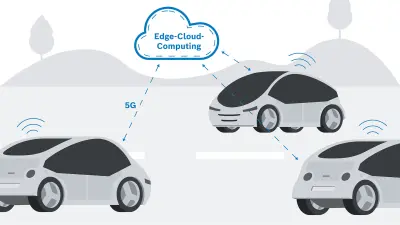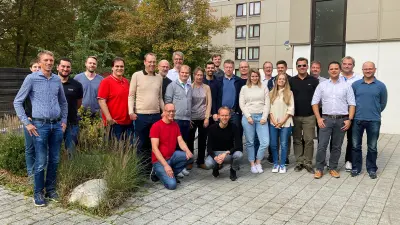Bosch is expanding vehicle functionality with edge cloud computing
The aim of the IPCEI-CIS project funded by the European Union is to realize safety and time-critical applications in a edge-cloud continuum.

Thanks to modern technology, driving is becoming more and more safe and comfortable. Various driver assistance systems such as adaptive cruise control, brake assist and traffic jam assist play a significant role here. Their capabilities are largely and increasingly influenced by software features, which is why we now talk about software-defined vehicles (SdV). If these software applications are to function in an SdV, computing power that can process large amounts of data and calculate and enable complex processes in the shortest possible time is needed. Fast and correct execution is of enormous importance, particularly in safety and time-critical situations in road traffic.
However, these additional features and assistance systems do have their downside: Given the high computing requirements of the software applications, the SdV needs more resources in terms of both energy and computing power. Among other things, this significantly limits the range of electric vehicles, while increasing the need for additional computing power and thus the costs. In addition, software updates and expansions during the vehicle's service life are limited by the originally installed computing hardware. So what would it be like to design parts of such applications that go beyond the basic functionalities no longer in the vehicle itself but via 5G connectivity in a edge-cloud continuum and at the same time use information from the cloud?
This is exactly what Bosch Research is working on now with the “CUBE-C — Cyber-Physical Systems (CPS) Cloud Continuum” project which forms part of IPCEI-CIS. The acronym of the projects name stands for “Important Project of Common European Interest for Next Generation Cloud Infrastructure and Services”. The aim of the project is to create an energy-efficient and cost-efficient solution for safety and real-time-critical software functionalities using edge/cloud computing power, all with reliably low latencies.
Over 100 companies and research institutions from twelve EU member states are involved in the European IPCEI-CIS project. The main objective is to create a new decentralized software infrastructure that is operated by several providers and reduces technological dependencies and lock-in effects. This should allow new data-driven business models, particularly in the areas of artificial intelligence and IoT.

With the european kick-off in March 2024, the Bosch Research team officially began taking part in the project. As the project manager and driver, Bosch Research is developing methods, modules and tools together with the Bosch Power Solutions and Cross-Domain Solutions divisions and the Bosch subsidiary ETAS to ensure resource-saving, energy-efficient and safe vehicle operation. In addition, the first new software applications that use the edge-cloud continuum are being developed on this basis. To this end, Bosch is working with European telecommunications companies, among others.
Bosch will receive funding for a total of three years, with the aim of achieving the project goal in 2026. Through product-related project participation, the latest developments from research can flow directly into product development within the divisions and can also be made available outside Bosch via ETAS.